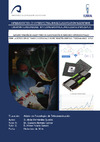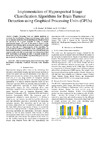Identificador persistente para citar o vincular este elemento:
https://accedacris.ulpgc.es/jspui/handle/10553/77431
| Título: | Implementación de Algoritmos de Clasificación de Imágenes Hiperespectrales para la Detección de Tumores sobre Tarjetas Gráficas Programables (GPUs) | Otros títulos: | Implementation of Hyperspectral Image Classification Algorithms for Brain Tumor Detection Using Graphical Processing Units (GPUS) | Autores/as: | Hernández Guedes, Abián | Director/a : | Marrero Callicó, Gustavo Iván Fabelo Gómez, Himar Antonio |
Clasificación UNESCO: | 3325 Tecnología de las telecomunicaciones | Fecha de publicación: | 2017 | Proyectos: | Hyperspectral Imaging Cancer Detection (Helicoid) (Contrato Nº 618080) | Resumen: | Graphics Processing Units (GPUs) have become extremely popular in the high-performance computing area due to its massively parallel hardware architecture. This architecture allows to exploit abundant data level parallelism while reducing power consumption in the instruction fetching, decoding, and issuing. For this reason, GPUs are suitable platforms to accelerate the classification of hyperspectral images which are an emerging technology for medical diagnosis. Hyperspectral imaging sensors measure the radiance of the materials within each pixel area at a very large number of contiguous spectral wavelengths, exploiting the fact that all materials reflect, absorb or emit electromagnetic energy, at specific wavelengths, in distinctive patterns related to their molecular composition. Hyperspectral data can be processed using multiples different supervised learning algorithms to detect human brain tumour tissue. Random Forest, a machine learning method that has become popular in object detection tasks in the computer vision community, has proved to be a good candidate in order to classify hyperspectral images. Generally, training a Random Forest model on large datasets is computationally demanding and makes scientific research difficult since the process requires too much computational time if there is not available a high performance computing platform. The goal of this Master’s Thesis is focused in the Random Forest training phase acceleration using GPUs, starting from an efficiently sequential implementation of this algorithm. We present multiple bottlenecks identified in the training phase and a solution for these bottlenecks in order to accelerate the algorithms. The different bottleneck solutions achieved in this research study have demonstrated that GPU acceleration is promising in order to generate models in a shorter time, giving the possibility to perform this process in real-time in a close future. | Facultad: | Escuela de Ingeniería de Telecomunicación y Electrónica | Instituto: | IU de Microelectrónica Aplicada | Titulación: | Máster Universitario en Tecnologías de Telecomunicación | URI: | https://accedacris.ulpgc.es/handle/10553/77431 |
| Colección: | Trabajo final de máster |
En el caso de que no encuentre el documento puede ser debido a que el centro o las/os autoras/es no autorizan su publicación. Si tiene verdadero interés en el contenido del mismo, puede dirigirse al director/a o directores/as del trabajo cuyos datos encontrará más arriba.
Vista completaVisitas
217
actualizado el 10-ene-2026
Descargas
116
actualizado el 10-ene-2026
Google ScholarTM
Verifica
Comparte
Exporta metadatos
Los elementos en ULPGC accedaCRIS están protegidos por derechos de autor con todos los derechos reservados, a menos que se indique lo contrario.


